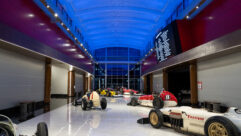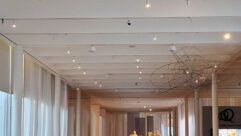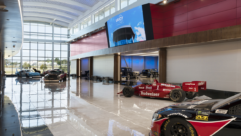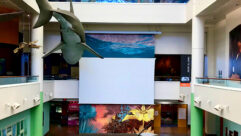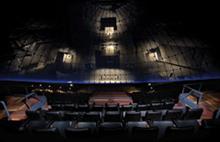

Under the Dome at a Chicago Museum
Chicago’s Museum of Science and Industry is known for its innovative programming and exhibits.
Chicago’s Museum of Science and Industry is known for its innovative programming and exhibits. When the Henry Crown Space Center was added to the museum in July 1986, it included a simulated space station, artifacts from the Apollo 8 and Aurora 7 Mercury missions, as well as the city’s only five-story domed Omnimax Theater (recently rebranded as IMAX Dome). Today, the Museum of Science and Industry is one of the busiest museums in the country, with more than 1.6 million visitors in 2007.
Integrating AV and show control with IMAX technology is a specialized skill, more so when combined with the tight time lines for a busy museum. “The plan was to complete the renovation in two phases during our slower months of January and September. Funding time lines shifted the plan to June and September,” explains Chapman. “The first phase was a two-week shutdown for speaker and amplifier work that still left us functional for the summer.”
CHALLENGE: Replace an aging AV system in Chicago’s only five-story, domed IMAX theater, located in one of the country’s busiest museums.
SOLUTION: Combine a proprietary turnkey media server and control system for large screen cinemas with specially developed loudspeakers.
The Museum of Science and Industry’s IMAX Dome includes 180 feet of LED lighting, which could save it 85 percent in energy costs.
Credit: Courtesy Mediamerge
So when its large-screen attraction began showing its age, the museum couldn’t afford to stand pat.
Kathryn Chapman, former manager of Omnimax and guest operations for the museum, handled operations for the theater including floor operations and guest processing. She also provided management oversight for the recent $400,000 technical renovation of the Omnimax theater.
Custom Sound
Credit: Danley Sound Labs
When it came time to specify products for the Omnimax Theater’s new sound system, Tim Ogletree at MediaMerge called Danley Sound Labs. Mike Hedden, president of Danley Sound, and Ogletree had kept in touch over the years and finally found a way to work together. “Tim called me regarding the IMAX project and wanted a loudspeaker with the sonic characteristics of our SH-50, but he couldn’t fit a pair in the space provided,” explains Hedden. “He needed a single, passive box with a 90-by-60-degree coverage pattern and there wasn’t one on the market that fit what he wanted.”
Ogletree adds: “Danley had the technology that fit the listening profile of the theater. We needed a high powered, high fidelity loudspeaker that could deliver impactful sound.”
The time line from that first phone call to the finished product was a mere six weeks. Hedden credits Danley’s ability to build an original product so quickly to the fact that they manufacture in the U.S. The company builds prototypes in-house in its Georgia facility, with additional manufacturing support in North Carolina.
Without the worry of shipping time from overseas, Danley was able to concentrate on developing the SH-96 with pattern control down to around 100 Hz and a flat-phase response and flat magnitude for three pass bands. “We are all about horns,” says Hedden. “They are the foundation of what was good about early sound systems before logistics became more important than good sound. Our cabs are quiet at the back; they provide direct sound to the audience so that rest of the theater is quiet. It’s not energizing the room like other systems. To the listener, the speakers practically disappear.”
“This is the second refresh since the theater opened 22 years ago. It was the second replacement for seats, carpet, and speakers, but this was the biggest project to date,” she notes. “What we needed was new, reliable technology. The initial problem was that the current equipment running the show was failing. We would lose audio during the show, and the projectionist had to run downstairs and reseat the sound cards. Before the renovation, we were down to four out of the six audio channels.”
After a highly focused bid process, the museum chose MediaMerge of Chelsea, Ala., to head the AV portion of the renovation. Chapman explains, “When it came to selecting the integrator, Media-Merge’s prices were competitive. They offered the best value and were dedicated to a quality show experience, with a focus on aspects like non-film lighting and pre-show.”
Founded in 2001, MediaMerge is a design/build firm that provides turnkey sound, video, and lighting systems. The company is currently the world’s largest third-party servicing agent for IMAX technology. A large part of MediaMerge’s integration work includes the house of worship market, but company owners Ken McKibben, Tim Ogletree, and Doug Jackson also have deep roots in large-format cinema from their previous experience at other companies.
The firm is a shared service provider for the museum, whose current technician has serviced the theater for the past 10 years. “We have a long-standing relationship with the museum. When it came time for them to renovate their theater, there were several AV aspects to address, [such as] the state of the audio system, the replacement of the neon lights in the coves around the dome, and the outdated show control,” explains McKibben, who oversees operations for MediaMerge.
IMAX technology is the predominate brand of large-format motion picture presentation and is synonymous with a truly immersive experience. According to IMAX Corp., there are 295 IMAX theaters in 40 countries; all theaters are purpose-built and are equipped with the specific projection and screen technology that comprises the “IMAX experience.” Omnimax theaters take that experience one step further due to the projection on a tilted dome screen, which takes up more of the viewer’s peripheral vision.
Specialized Skills
In the theater’s control room, operators have manual and/or automated control over show sources through a touch screen that gives them access to lighting presets, background music, and more.
Credit: Courtesy Mediamerge
MediaMerge installed four Danley Sound Labs TH-50 subwoofers and six Danley Sound Labs SH-96 loudspeakers in a one-for-one swap with the old equipment. IMAX theater design requires the placement of loudspeakers behind the screen and at distributed points throughout the space. The challenge for the install team came when it was time to remove the old speakers, which were mounted above the dome and accessible via catwalks.
“Our team had to saw the old speakers apart to get them out,” says Ogletree, who oversees system engineering for MediaMerge. “The rigging was engineered on site due to the unique nature of the dome.”
The second phase of the install came in September and included the task of integrating the Media-Merge ShowSource3D media server and installing a Digital Projection Lightning 40isx+ 22,000 lumen DLP projector for pre-show and special event presentations. The ShowSource platform was developed specifically for super-large screen cinema venues and addresses the challenge of playing back multichannel audio files that are synchronized with the IMAX projector.
“Chicago has the traditional IMAX projector,” says Ogletree. “As a point of evolution, the original digital audio playback used three sample-locked CD players. Today, the ShowSource media server streams the companion six-channel uncompressed digital audio file via CobraNet to a Biamp DSP with amplification provided by Lab.gruppen amplifiers.”
The ShowSource3D also serves as a video source and show control engine for the new system. The power and flexibility of the ShowSource platform are best seen during the pre-show, where it can change equipment settings, play HD video files or still images via the DLP projector, and play prerecorded announcements and background music either free-running or chasing time code.
“The new system brings flexibility to the museum’s presentation capability,” adds Ogletree. “Most clients have a general idea of what capabilities they want and the museum knew they wanted the flexibility to run automated shows and control the theater as simply as possible. The ShowSource3D achieves this by integrating all the various elements into one streamlined platform.”
Manual AV source control and automated show control is accessed via a touch screen, with a GUI that includes show sequence playback, lighting presets, automated announcements, and background music. “It’s intentionally easy enough that non-technical staff can run it,” says Ogletree, who notes that ShowSource3D uses primarily off-the-shelf components and can be customized for specific theater needs.
LED Coves
Equipment List
Below is a partial list of the equipment installed by Media-Merge at Chicago’s Museum of Science and Industry.
- Analog Way Quatro-D switcher/scaler
- Biamp AudiaFLEX CM chassis
- Biamp Audia EXPI CobraNet input module
- 6 Danley Sound Labs SH-96 loudspeakers
- 4 Danley Sound TH-50 subwoofers
- Denon DN-A7100 switching surround decoder
- Denon DVD-3800BDCI Blu-ray player
- Digital Projection (DPI) Lightning 40isx+ 22K lumen DLP projector
- Dtrovision DX-6600 Pro 6×6 DVI matrix switcher
- Elo 15-inch LCD touch monitor
- 3 Lab.gruppen C68:4 four channel amplifiers
- MediaMerge ShowSource3D multichannel sound and video server for cinema
- Telex intercom system
Source: Mediamerge
The final touches to the theater came in the form of 180 feet of LED cove lighting in the dome structure. The museum is able to color mix the lighting to further customize the pre-show experience. ShowSource3D also controls the presets and color wash effects using a DMX control interface.
McKibben calculated that the museum will enjoy an 85-percent increase in energy savings per year by switching from neon lighting to LEDs. “After seven or eight years, they will reach the break-even point with plenty of life left on the system,” he says.
Ogletree adds that there are several enhancements to the new system that will ensure it keeps pace with future changes in technology. The Biamp AudiaFLEX DSP with CobraNet ensures that new input devices are easily handled. The ShowSource3D also features capabilities to play large-format high resolution 3D video “when digital projection technology catches up,” he explains.
Chapman is satisfied with the renovation, “Media-Merge met a really tough deadline. We trusted them with the product selection and we are pleased. The theater looks great with the new lighting. For the projectionists, the new equipment means that this is a stable system so no more running up and down the stairs to fix the sound during a show.”
Linda Seid Frembes is a Pro AV contributing editor.



